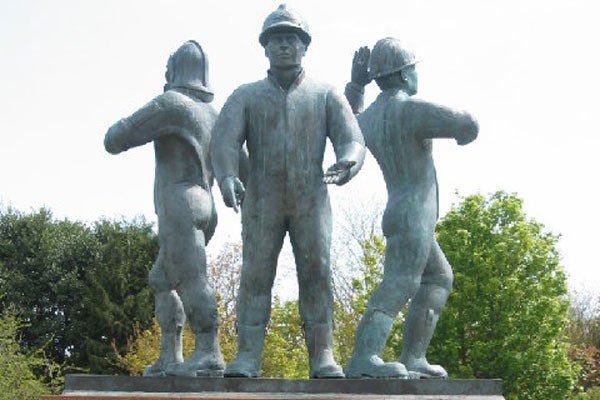
The Piper Alpha disaster in the North Sea, UK, remains the worst offshore oil disaster in history after 167 people lost their lives in July 1988. But what are the remaining worst offshore oil rig disasters?
Piper Alpha, North Sea, United Kingdom
The Piper Alpha disaster in the North Sea, UK, which killed 167 people in July 1988, is the deadliest offshore oil rig accident in history.
Discovered in 1973 and brought on stream in 1976, Piper Alpha was one of the biggest offshore oil platforms in the UK producing more than 300,000 barrels of crude a day (about ten percent of the country’s total crude production). The offshore platform started producing gas in the early 1980s and had three main gas transport risers and an oil export riser before disaster struck, destroying the entire facility causing an estimated loss of $1.4bn.
The Piper Alpha disaster occurred due to gas leakage from one of the condensate pipes at the platform on 6 July 1988. The pressure safety valve of the corresponding condensate-injection pump was removed during the day as part the routine maintenance of the pump. The open condensate pipe was temporarily sealed with two blind flanges. The temporary disc cover, however, remained in place during shift-change in the evening as maintenance work was not complete. The condensate-injection pump was not supposed to be switched on under any circumstances.
Communication errors however led the night crew staff at the platform to turn on the pump after the other pump tripped. It resulted in leakage of gas condensate from the two blind flanges causing gas ignition and serial explosions on the platform. Only 61 out of the 226 workers survived the disaster and it took close to three weeks to control the fire.
At the time of the disaster the platform was managed by Occidental in block 15 of the UK Continental Shelf, about 120 miles north-east of Aberdeen.
How well do you really know your competitors?
Access the most comprehensive Company Profiles on the market, powered by GlobalData. Save hours of research. Gain competitive edge.

Thank you!
Your download email will arrive shortly
Not ready to buy yet? Download a free sample
We are confident about the unique quality of our Company Profiles. However, we want you to make the most beneficial decision for your business, so we offer a free sample that you can download by submitting the below form
By GlobalDataAlexander L. Kielland, North Sea, Norway
The Alexander L. Kielland was a semi-submersible platform accommodating the workers of the bridge-linked Edda oil rig in the Ekofisk field, about 235 miles east of Dundee, Scotland, in the Norwegian continental Shelf. The Platform, operated by Phillips Petroleum, capsized in March 1980, killing 123 people.
Only 89 out of 212 workers survived the accident and most died by drowning as the platform turned upside down in deep waters. The platform capsized after the failure of one of the bracings attached to one leg of the five-legged platform structure, after strong winds created waves of up to 12m high on the day of the accident.
Once the first broke, all bracings attached to the leg failed in succession, the platform lost one of its five legs and the entire structure tilted 30 degrees. Five of the six anchor cables snapped but the platform was stabilised for some time by the remaining single cable, which ultimately snapped.
Official investigation concluded that the root cause of the accident was an undetected fatigue crack in the weld of an instrument connection on the bracing.
Seacrest Drillship disaster, South China Sea, Thailand
The Seacrest Drillship disaster in the South China Sea 430km south of Bangkok, Thailand, killed 91 crew men on the 3rd of November 1989. The 4,400t drillship was anchored for drilling at the Platong gas field owned and operated by Unocal. The drillship was capsized by the Typhoon Gay which produced 40ft high waves on the day of the accident.
The Seacrest drillship, also known as The Scan Queen, had been operational in the Gulf of Thailand since 1981 as a drill ship for Unocal. The drillship was reported missing on 4 November 1989 and only found floating upside-down by a search helicopter the next day. The capsize was believed to have occurred so quickly that there was no distress signal and no time for the crew members to respond to the disaster.
Just six out of the 97 crew members onboard were rescued by fishing boats and the Thai Navy. Apart from the severe weather condition the seaworthiness of the drillship was questioned as the likely cause for the tragedy.
The ship also had 12,500ft of drill-pipe in its derrick, which was believed to have resulted in a unstable high centre of gravity.
Ocean Ranger oil rig disaster, Canada
The Ocean Ranger oil drilling rig disaster which occurred in the North Atlantic Sea off the coast of Newfoundland, Canada, on 15 February 1982 is one of the deadliest offshore oil rig accidents in history. The offshore oil drilling capsized and sank killing 84 crew members onboard.
The semi-submersible mobile offshore drilling rig owned by Ocean Drilling and Exploration Company (ODECO) was hired by Mobil Oil of Canada for drilling exploration well at Hibernia field at the time of accident. One of the biggest rigs built by then, the 25,000t rig was 396ft long, 262ft wide and 337ft tall, with the capacity to operate 1,500ft beneath water and drill up to a depth of 25,000ft below the seabed.
The rig was capsized due to a very strong storm which produced 190km/h winds and up to 65ft (20m) high waves. On 14 February 1982, it was reported that a porthole window had broken and water had entered into the ballast control room of the Ocean Ranger. The ballast control panel was noticed to be malfunctioning two hours later.
Crew workers abandoned the rig and moved into the lifeboat stations but only one lifeboat with 36 crew members inside could be launched successfully. At least 20 crew were reported to be in the water before the rig sank between 3:07am and 3:13am after staying afloat for about one and half hours. Out of the 84 workers who drowned, 46 were Mobil Oil employees.
Glomar Java Sea Drillship disaster, South China Sea
The Glomar Java Sea Drillship disaster which took place on 25 October 1983 in the South China Sea caused the death of 81 people when the drillship capsized and sank at depth of 317ft about 63 nautical miles south-west of Hainan Island, China, 80 nautical miles east of Vietnam.
The 5,930t Glomar Java Sea drillship was built by the Levingston Shipbuilding Company of Orange, Texas, in 1975 and delivered to Global Marine. The 400ft long drillship was contracted to ARCO China at the time of the disaster. The vessel had performed drilling for ARCO in the Gulf of Mexico between 1975 and 1881, and operated off the coast of California for some time before its arrival in the South China Sea in January 1983.
Operations ceased prior to the arrival of tropical Storm Lex as it approached from the east of the drilling site. Global Marine’s office in Houston, Texas, reported that the drillship was experiencing 75kt (138.9km/h) winds over the bow, but the contact was abruptly lost.
No survivors were found in the extensive search operation conducted thereafter. The wrecked drillship was found in an inverted position 1,600ft south-west of the drilling site. Only 36 bodies were found, and the remaining 45 crew members were presumed dead.
Bohai 2 oil rig disaster, China
The Bohai 2 oil rig disaster in the Gulf of Bohai off the coast of China in November 1979 is the sixth most fatal offshore oil rig disaster. It caused the death of 72 out of 76 people on board as the Bohai 2 jack-up rig capsized and toppled in the sea water.
The accident was caused by a storm which occurred while the rig was being towed. Fierce winds broke the ventilator pump of the platform causing a puncture hole in the deck resulting in extensive flooding.
The loss of stability due to flooding coupled with severe weather conditions eventually led to the capsizing of the jack-up. The accompanying tow boat could not rescue the crew members, who were also believed to lack proper training on emergency evacuation procedures and the use of lifesaving equipment.
The post-disaster investigations reported a failure in correctly stowing the deck equipment prior to towing. It was also reported that standard tow procedures were not followed given the bad weather conditions. The sunken jack-up rig was eventually salvaged with explosives by the Yantai Salvage Company in April 1981.
Enchova Central Platform disaster, Brazil
The Enchova Central Platform disaster in the Campos Basin near Rio de Janeiro, Brazil, killed 42 people in August 1984. The accident occurred due to a blowout which caused a fire and explosion at the central platform of the Enchova field operated by Petrobras.
Most of the workers were evacuated from the platform by lifeboats and helicopter except for 42 workers who lost their lives during the evacuation process. Malfunctioning of the lowering mechanism of a lifeboat caused the death of 36, while six died as they jumped from the platform into the sea. The lifeboat remained vertically suspended because of the failure of the bow hook and eventually fell 20m deep into the sea as its supporting cables snapped.
Another disaster struck the Enchova platform on 24 April 1988 as one of its 21 wells blew out and eventually ignited. The well suffered a blow out while undergoing a work-over to convert it from oil production to gas production. The fire caused by the blowout on the platform led to massive damage topside, however all the workers were safely evacuated to the nearby floating accommodation ship without a single casualty.
The platform remained on fire for a month and Petrobras eventually drilled two relief wells to control the blowout. The platform was declared a total loss and replaced by a new facility that commenced production nearly 18 months after the accident.
Mumbai High North disaster, Indian Ocean
The Mumbai High North disaster on 27 July 2005 in the Arabian Sea, around 160km west of the Mumbai coast, killed 22 people. Mumbai High North, one of the producing platforms of the Mumbai High field owned and operated by India’s state-owned Oil and Natural Gas Corporation (ONGC), caught fire after a collision with the multipurpose support vessel (MSV) Samudra Suraksha.
Strong swells, pushed the MSV towards the platform hitting the rear part of the vessel causing rupture of one or more of the platform’s gas export risers.
The resultant gas leakage led to ignition that set the platform on fire. Heat radiation also caused damage to the MSV and the Noble Charlie Yester jack-up rig engaged in drilling operation near the platform.
The accident caused significant oil spill and a production loss of about 120,000 barrels of oil and about 4.4 million cubic metres of gas a day. ONGC opened a new platform at Mumbai High North in October 2012.
Usumacinta Jack-up disaster, Gulf of Mexico
The Usumacinta Jack-up disaster, which occurred on the 23rd of October 2007 in the Gulf of Mexico, claimed 22 lives after a collision with the PEMEX-operated Kab-101 platform in the Bay of Campeche.
The Usumacinta Jack-up was positioned alongside the Kab-101 platform to complete drilling of the Kab-103 well. A storm with winds of 130km/h and up to 8m of waves created an oscillating movement, which eventually caused its cantilever deck to hit the production valve tree on the Kab-101 platform.
The collision resulted in oil and gas leakage leading to the closure of the safety valves of two production wells at the platform. The crew members were, however, unable to seal the valves completely, which resulted in continued leakage of oil and gas which eventually ignited causing fires on the platform. 21 people were declared to have died during the evacuation and one worker missing in the rescue operation was presumed dead.
The Usumacinta Jack-up also suffered two more fire breakouts in the month the followed, during well control operations. The fire was, however, extinguished without any loss of life and complete control of the well was achieved by the middle of December 2007. Approximately 5,000 barrels of oil was reported to have lost from the well without being recovered.
C.P. Baker Drilling Barge disaster, Gulf of Mexico
The C.P. Baker Drilling Barge disaster in the Gulf of Mexico on 30 June 1964 resulted in the death of 21 people and injured 22 after fires and a explosion occurred on the drilling barge.
C.P. Baker Drilling Barge constructed Reading & Bates in 1962 was deployed for drilling operation for Pan American Petroleum Corporation in block 273 in Eugene Island, Gulf of Mexico, at the time of the accident.
The two 260ft long hulls suffered a blowout on morning of 30 June 1964. Water gushed into the vessel through open doors on the main deck and the barge lost electric power soon thereafter.
The entire drilling barge was engulfed with fire and explosion just minutes of noticing the blow out. Only 22 out of the total 43 crew on board survived the disaster, most of which saved their lives by jumping from the port bow. The vessel sank upside-down in the water after heeling aft for around 30 minutes. The rescue operation confirmed eight as dead and 13 crew missing who were presumed dead.






